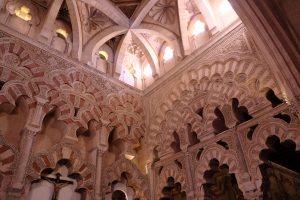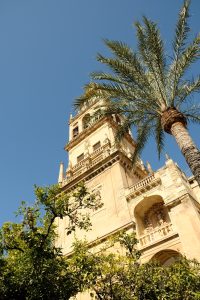By: Ines Jordan-Zoob
Our trip to Spain meant that we were able to see the architectural treasures from the period focused on in our class, 711-1492. These buildings included mosques, churches, synagogues, palaces, fortresses, and cathedrals. Visiting the cities of Córdoba, Sevilla, and Granada revealed the rich layers of Spanish history, from Visigothic times, to Muslim rule, and to the eventual Christian Reconquista. These histories remain acutely tangible to contemporary audiences because of the architecture of Andalusia, which features Moorish, Amoravid and Almohad styles, as well as Mudéjar, Romanesque, Gothic, Renaissance, and Baroque styles. Nearly every prominent building we visited revealed layers of history just in their architectural exterior alone, with even more plurality on display inside.

These buildings made me think a lot. I looked up to the bell tower of the Córdoba Mosque-Cathedral and couldn’t help but imagine the minaret that once existed in its place. I couldn’t help but notice how Spaniards simply referred to the building as the mezquita or mosque, rather than as a cathedral. With our tour guide we walked along the ruins of a small Visigoth church, only to end up peering at the 856 columns of the Great Mosque, which was constructed by Abd al-Rahman I in 784. A few steps later, and I was engulfed in an incredibly richly-decorated Renaissance cathedral nave. The juxtaposition of different religious architecture so close together is at once overwhelming and awe-inspiring. There are distinct visual tensions at play here, with immense golden horseshoe arches denoting the mihrab and marble circular arches surrounding the altar.

I struggled to understand how to appreciate this building. Do I think of it as a church? Can it be a mosque if Muslims continue to be restricted from using the space for prayer? Why were these different groups so compelled to transform this space from each of its previous incarnations? How powerful can architecture be in establishing and/or undermining not just political authority, but religious authority too? And perhaps, most importantly of all, does building over something every truly get rid of what lies below? The symbolic conversion of the original mosque lingers in my mind. The architectural multiplicity of Córdoba Mosque-Cathedral was one of the most fascinating things I saw on the trip. It would set the tone for virtually all of the other buildings we would see.


Our arrival in Seville led us quickly to the Cathedral there, the largest Gothic church in the world. Walking around the cathedral was dazzling. It is simply so big, and features such a variety of architectural design that it truly takes a few hours to absorb it all. The first thing one sees are the doors. The Door of the Bapitsm and the Door of Assumption, the Door of Saint Miguel, and the Door of the Prince, the Door of Palos, the Door of Forgiveness…the list goes on and on. Each one seems more intricately carved than the last, all brilliant examples of the Gothic style. And then, my eyes looked up. The giralda or bell-tower looms over the cathedral, somehow making it look small. A Renaissance-style top added by the Catholics after 1492 attempts to hide the original function of this tower, for of course, it was originally a minaret of the 1171 mosque commissioned by Abu Ya’qub Yusuf, but completed by his son, Abu Yusuf Yaqub al-Mansur.


The inside of the cathedral features a myriad of Gothic and Baroque architectural styles, and I would be remiss if I didn’t mention the 138-foot polychrome wood altarpiece. My audio-guide informed me that it is considered the largest altarpiece in Christendom, and I felt inclined to believe this. As I craned my neck to take in row upon row of relief sculpture, I tried to identify even a few of the saints depicted. After twenty minutes of viewing the altar, my eyes began to strain. I wandered out to the courtyard, known as the Patio de los Naranjos, where the smell of fragrant orange trees awakened my senses. I sat on a bench to take in this courtyard space. Now, it was merely a stopping point for tourist groups between the interior of the cathedral and the steps up to the bell tower. I closed my eyes and imagined what this space used to be, a long time ago. It was the mosque’s sahn, a courtyard for ablutions, where the faithful would come to ritually cleanse themselves before entering the mosque for prayer. I opened my eyes again and looked up to the giralda. I stared at the Christian sculpture that adorns its peak, and then at the Islamic bricks and marble that make up its base. These bricks and marble had been recycled from old Umayyad monuments. The sun was beaming, and for a second, I couldn’t tell which part was what. Histories and layers blurred together.

I am grateful for the opportunity we had to visit Spain and experience these beautiful sights. In less than eight days, we were able to immerse ourselves in this land, its history, its culture, and most importantly for me, its memories.
